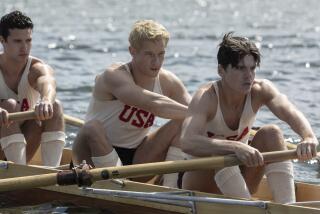The America’s Cup : Notebook : Conner Says Kiwis’ Bark Might Be Worse Than Even Their Boat
- Share via
SAN DIEGO — With all the talk about cats and dogs, someone forgot fish.
At the press conference after Wednesday’s Stars & Stripes victory, a New Zealand journalist asked winning skipper Dennis Conner if he had been “dogging it.”
The reference was to the 18-minute 15-second margin of victory, which the Kiwi challengers said was deceptively narrow.
“I’m racing a cat,” Conner said in reference to his lighter, smaller catamaran. “Someone else is racing the dog.”
Overlooked in the name-calling and innuendo-exchanging was something that teammates said Conner was delighted by: Close to the turning mark, near the midpoint of Wednesday’s race, Stars & Stripes was escorted by a school of dolphins. Dolphins are regarded by sailors as bringing good luck.
Of course, the Kiwis said dolphins had nothing to do with it. Technology and an aberration in rules were the culprits, they said.
In their words, teams of little Flippers were irrelevant.
The New Zealanders were fiercely critical of Conner and Co., and Wednesday may have spawned more barbs than ever before.
They took umbrage with Conner’s “celebration”--one challenger crew member’s phrase--of corporate America. Stars & Stripes bore insignias from Pepsi, Merrill Lynch and Marlboro. The most glaring symbol was a Diet Pepsi sail that Conner used in the latter half of the race.
As Stars & Stripes headed into the Marlboro compound near the Chart House restaurant, a photographer was heard to mumble:
“The SS Diet Pepsi is on its way in.”
Tom Whidden, Conner’s longtime tactician, said after tying up at the compound dock, “Believe it or not, it was pretty rough out there. I don’t care what people say. The winds were much heavier than we ever thought they’d be. We were surprised.”
A reporter from Radio New Zealand was telling some other reporters at the media center that Michael Fay may very well not mount another court challenge if the Kiwis lose, as expected.
The thinking among many New Zealand media seems to be that the time and money involved in returning to the courtroom won’t be worth the effort. They say that merchant banker Fay has already suffered a backlash in his native land.
“On the other hand,” said one, “look at all the publicity that this has brought New Zealand. It’s incredible. How would we have gotten that otherwise?”
About halfway through the race, ESPN stopped receiving pictures from its seven cameras aboard New Zealand and Stars & Stripes.
The network was investigating the cause of the breakoff, said Chris La Placa, ESPN director of communications, and was hoping to have the problem solved by Friday’s race. The network’s computer graphics package also malfunctioned about midway through the race.
The network has had to contend with several unique obstacles, among them the intense radio frequency traffic in San Diego Bay.
ABC television, which planned to air a preview of the Cup on its program, “Nightline,” Tuesday night, instead aired another broadcast.
Not everyone failed to notice the significance of Wednesday’s dolphins. Rob Tucker, 40, a photographer from Auckland, New Zealand, said dolphins were about all he had to photograph during the race, and that adds up to a major disappointment.
Tucker wasn’t the only one complaining. Dozens of reporters from around the world were calling the story one of the more boring they’d ever covered.
“Can you believe it?” said a writer from a major yachting journal. “We’re sitting around watching television, as the way of covering the event.”
Writers who did go out on the water in press boats came back sunburned and seasick, saying they wish they had stayed inside, watching the tube. That way they wouldn’t have run out of the tubes of sunscreen they kept applying, in vain, to their sure-to-be-burned faces.
As several said with a sigh, the Kiwis weren’t the only ones to get burned.
“I can hardly wait ‘til Friday,” said a weary reporter as he asked for another beer.
Marc Pajot of France, who sailed the 12-meter French Kiss in the previous America’s Cup and also knows catamarans well, was asked his opinion of the controversy following the race.
Was Dennis Conner sandbagging? And, if so, was it wrong?
“The aim of Dennis was to win the race,” Pajot said. “So he does a perfect job. A catamaran is really faster than a monohull, and he didn’t need to prove that.”
As for New Zealand’s accusations that Conner made a “mockery” of the race, Pajot said, “It’s really difficult to say that if you are not on the boat.”
In Australia two years ago, it was “Danger Zone” by Kenny Loggins. This time it’s “Born In the USA,” by Bruce Springsteen.
The adopted theme blared from loudspeakers as the Stars & Stripes catamaran prepared to leave the dock, while female staffers cheered and waved red, white and blue balloons, trying to recreate the festive air of Fremantle.
Tactician Peter Lester spelled David Barnes at the helm of the New Zealand boat for the first hour and a half of the downwind leg, but that has been standard practice in tuneups.
Not standard was bowman Peter Warren having to be hauled to the top of the 153-foot mast on the downwind leg to clear a jammed halyard.
The Kiwis also showed an unconventional move when they had their “rail crew” sitting on the leeward (off-wind) side of the boat to induce heel and make the sails more efficient in the light wind.
Times staff writer Rich Roberts and Tom Krasovic contributed to this story.
More to Read
Go beyond the scoreboard
Get the latest on L.A.'s teams in the daily Sports Report newsletter.
You may occasionally receive promotional content from the Los Angeles Times.










